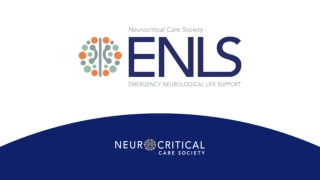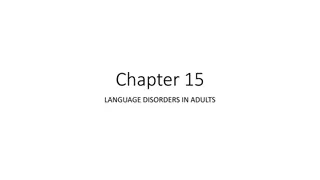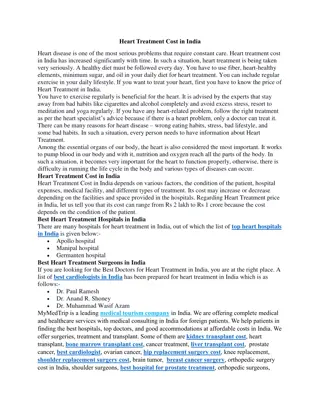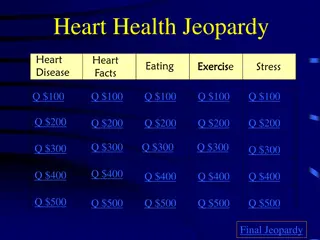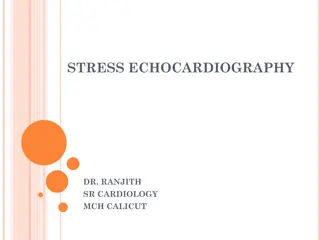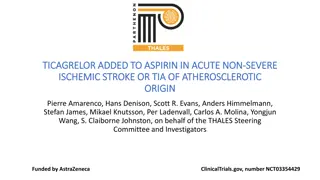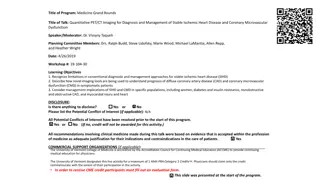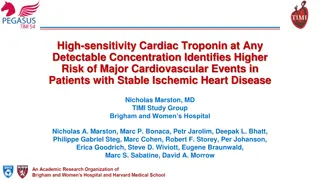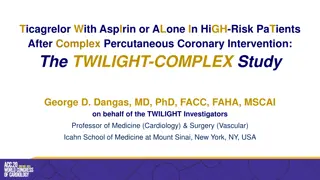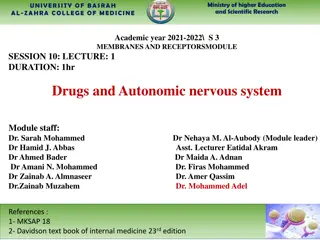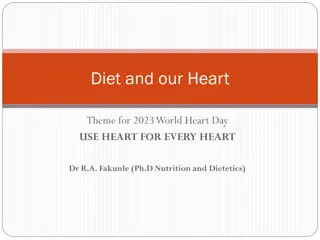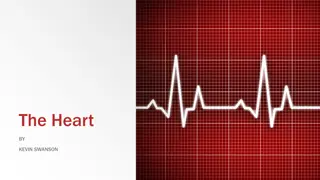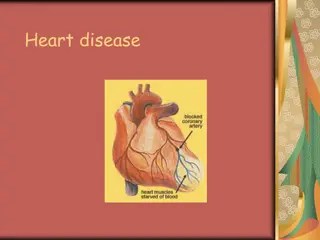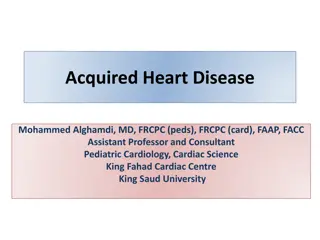Treating Ischemic Heart Disease: Goals and Strategies
Lifestyle modifications and drug treatments play a crucial role in managing ischemic heart disease (IHD). The primary goals include preventing acute coronary syndromes, alleviating symptoms of myocardial ischemia, and minimizing adverse effects. Lifestyle changes like smoking cessation, dietary modifications, and increased physical activity are recommended. Drug therapies such as short-acting nitrates, antiplatelet therapy with aspirin, ACE inhibitors, and statins are important components of treatment for chronic stable angina and IHD.
Download Presentation

Please find below an Image/Link to download the presentation.
The content on the website is provided AS IS for your information and personal use only. It may not be sold, licensed, or shared on other websites without obtaining consent from the author.If you encounter any issues during the download, it is possible that the publisher has removed the file from their server.
You are allowed to download the files provided on this website for personal or commercial use, subject to the condition that they are used lawfully. All files are the property of their respective owners.
The content on the website is provided AS IS for your information and personal use only. It may not be sold, licensed, or shared on other websites without obtaining consent from the author.
E N D
Presentation Transcript
Done by: Assist.lec. Shaymaa Hasan Abbas
The major goals for the treatment of IHD are to: Prevent acute coronary syndromes and death Alleviate acute symptoms of myocardial ischemia Prevent recurrent symptoms of myocardial ischemia and Avoid or minimize adverse treatment effects.
Lifestyle modifications include smoking cessation, dietary modifications, increased physical activity, and weight loss.
Since chronic stable angina usually results from increased myocardial oxygen demand in the face of a relatively fixed reduction in oxygen supply, drug treatment is primarily aimed at reducing oxygen demand.
1- Short- acting nitrates are indicated to acutely relieve angina. All patients with a history of angina should have sublingual nitroglycerin tablets or spray to relieve acute ischemic symptoms at the onset of an angina attack, a 0.3 to 0.4 mg dose of nitroglycerin (tablet or spray) should be administered sublingually, and repeated every 5 minutes until symptoms resolve.
2- Antiplatelet therapy with aspirin should be considered for all patients without contraindications, particularly in patients with a history of myocardial infarction. Aspirin doses of 75 to 325 mg daily have been shown to be cardioprotective. If aspirin is contraindicated (e.g., aspirin allergy, active peptic ulcer disease, or active internal bleeding) or is not tolerated by the patient, other antiplatelet agents such as clopidogrel should be considered.
3- ACE inhibitors should be considered in ischemic heart disease patients who also have diabetes mellitus, left ventricular dysfunction, history of myocardial infarction, or any combination of these.
4- Patients with chronic stable angina should receive statin therapy unless contraindicated. - statins and angiotensin-converting enzyme (ACE) inhibitors are believed to provide vasculoprotective effects (properties that are generally protective of the vasculature, which may include anti-inflammatory effects, antiplatelet effects, improvement in endothelial function, and improvement in arterial compliance and tone), and in addition to aspirin, have been shown to reduce the risk of acute coronary events as well as mortality in patients with IHD
5- B Blockers, calcium channel blockers (CCBs), and long acting nitrates are traditionally used to prevent ischemic symptoms, reduce the frequency of angina and improve exercise tolerance.
5- B-Blockers are first-line therapy for preventing ischemic symptoms, particularly in patients with a history of myocardial infarction. - b-Blockers have been shown to decrease morbidity and improve survival in patients who have suffered an MI. Calcium channel blockers are recommended as initial treatment in IHD when B-blockers are contraindicated or not tolerated. In addition, CCBs may be used in combination with b-blockers when initial treatment is unsuccessful. Treatment with long-acting nitrates should be added to baseline therapy with either a B-blocker or calcium channel blocker or a combination of the two.
- In most patients with IHD, the most effective treatments to improve myocardial oxygen supply are invasive mechanical interventions: percutaneous coronary intervention (PCI) and coronary artery bypass graft (CABG) surgery. Percutaneous Coronary Intervention When drug therapy fails or if extensive coronary atherosclerosis is present, PCI is often performed to restore coronary blood flow, relieve symptoms, and prevent major adverse cardiac events. Patients with one or more critical coronary stenoses (i.e., greater than 70% occlusion of the coronary lumen) detected during coronary angiography may be candidates for PCI.
Several catheter-based interventions may be used during PCI, including: Percutaneous transluminal coronary angioplasty (PTCA); Intracoronary bare metal stent placement; Intracoronary drug-eluting stent placement; and Rotational atherectomy.
In chronic stable angina, percutaneous coronary intervention is reserved for patients who remain symptomatic despite optimal medical therapy, patients unable to tolerate adverse effects of medications, and those with high-risk findings on noninvasive imaging. Patients with stable angina who undergo percutaneous coronary intervention should receive clopidogrel for 6 monthes following placement of a drug-eluting stent and for 2 weeks to 1 month following placement of a bare-metal stent; aspirin should be continued indefinitely.
Coronary Artery Bypass Graft Surgery As an alternative to PCI, CABG surgery, or open- heart surgery, may be performed if the patient is found to have extensive coronary atherosclerosis (generally greater than 70% occlusion of three or more coronary arteries) or is refractory to medical treatment. In the former case, CABG surgery has been shown to reduce mortality from IHD.


